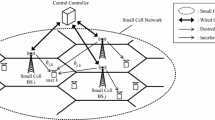Abstract
In this paper, a power saving scheme is investigated for macrocell-assisted small cell networks in the downlink, in which small cells are selected to stay in sleep or wake-up modes in order to mitigate excessive power consumption and the small cells operating in the sleep mode are eligible to off-load their served users to the macrocell to preserve communications. By taking the dynamics of user arrival into account, we attempt to minimize the average total power consumption of the network, which depends on several network parameters like power consumption of base stations, available bandwidth, user load in the cells, cell size, user rate requirement, rate outage probability and noise power density, while ensuring the average number of dropping off-loaded users to a satisfactory level. The design problem is then formulated as a constrained Markov decision process and solved via linear programming. A randomized strategy is proposed to accomplish the optimal sleep/wake-up policy for small cells. Simulation results confirm the effectiveness of the proposed scheme, as compared with the one without adopting sleep/wake-up mechanisms, and help us to capture the impact of the network parameters on the entire power saving.











Similar content being viewed by others
References
Ghosh, A., Mangalvedhe, N., Ratasuk, R., Mondal, B., Cudak, M., Visotsky, E., Thomas, T. A., Andrews, J.G., Xia, P., Jo, H.S., Dhillon, H.S., & Novlan, T.D. (2012). Heterogeneous cellular networks: From theory to practice. IEEE Communications Magazine, 50(6), 54–64.
Wu, J., Zhang, Y., Zukerman, M., & Yung, E.K.N. (2015). Energy-efficient base-stations sleep-mode techniques in green cellular networks: A survey. IEEE Communications Surveys & Tutorials, 17(2), 803–826. 2nd Quart.
Ashraf, I., Boccardi, F., & Ho, L. (2011). SLEEP Mode techniques for small cell deployments. IEEE Communications Magazine, 49(8), 72–79.
Hasan, Z., Boostanimehr, H., & Bhargava, V.K. (2011). Green cellular networks: a survey, some research issues and challenges. IEEE Communications Surveys & Tutorials, 13, 524–540. 4th Quart.
Hu, R.Q., & Qian, Y. (2014). An energy efficient and spectrum efficient wireless heterogeneous network framework for 5G systems. IEEE Communications Magazine, 52(5), 94– 101.
de la Roche, G., Valcarce, A., Lopez-Perez, D., & Zhang, J. (2010). Access control mechanisms for femtocells. IEEE Communications Magazine, 48(1), 33–39.
Chen, C.S., Nguyen, V.M., & Thomas, L. (2012). On small cell network deployment: a comparative study of random and grid topologies. Proc. IEEE Vehicular Conference (VTC), pp. 1–5.
Sun, C., Stevens-Navarro, E., & Wong, V.W.S. (2008). A constrained MDP-based vertical handoff decision algorithm for 4G wireless networks. Proc. IEEE International Conference Communication (ICC), pp. 2169–2174.
Mao, T., Feng, G., Liang, L., Qin, S., & Wu, B. (2015). Distributed energy efficient power control for macro-femto networks. IEEE Transactions on Vehicular Technology, 65(2), 718–731.
Soh, Y.S., Quek, T.Q.S., Kountouris, M., & Shin, H. (2013). Energy efficient heterogeneous cellular networks. IEEE Journal on Selected Areas in Communications, 31(5), 840–850.
Jin, Y., Qiu, L., & Liang, X. (2015). Small cells on/off control and load balancing for green dense heterogeneous networks. Proc. IEEE Wireless Communication Network Conference (WCNC), pp. 1530–1535.
Wu, J., Liu, J., & Zhao, H. (2016). Dynamic small cell on/off control for green ultra-dense networks. Proc. Internationl Conference on Wireless Communication Signal Processing. (WCSP), pp. 1–5.
Liu, C., Natarajan, B., & Xia, H. (2016). Small cell base station sleep strategies for energy efficiency. IEEE Transactions on Vehicular Technology, 65(3), 1652–1661.
Celebi, H., Maxemchuk, N., Li, Y., & Guvenc, I. (2013). Energy reduction in small cell networks by a random on/off strategy. Proc IEEE Globecom Workshops, pp. 176–181.
Falconetti, L., Frenger, P., Kallin, H., & Rimhagen, T. (2012). Energy efficiency in heterogeneous networks. Proc. IEEE Online Conference Green Communication (GreenCom), pp. 98– 103.
Saker, L., Elayoubi, S., Combes, R., & Chahed, T. (2012). Optimal control of wake up mechanisms of femtocells in heterogeneous networks. IEEE Journal on Selected Areas in Communications, 30(3), 664–672.
Chiang, Y.H., & Liao, W. (2013). Genie: an optimal green policy for energy saving and traffic offloading in heterogeneous cellular networks. Proc. IEEE International Conference Communication (ICC), pp. 6230–6234.
Intel Corporation. (2013). Performance evaluation of small cell on/off (R1-132933) 3GPP TSG RAN WG1 Meeting-74.
Puterman, M. (1994). Markov decision Process-Discrete stochastic dynamic programming. Hoboken: Wiley.
Auer, G., Blume, O., Giannini, V., Godor, I., Imran, M.A., Jading, Y., Katranaras, E., Olsson, M., Sabella, D., Skillermark, P., & Wajda, W. (2010). Energy efficiency analysis of the reference systems, areas of improvements and target breakdown, EARTH D2.3, Tech. Rep.
Lustig, I.J., Marsten, R.E., & Shanno, D.F. (1991). Computational experience with a primal-dual interior point method for linear programming. Linear Algebra and its Applications, 152, 191– 222.
Auer, G., Giannini, V., Desset, C., Godor, I., Skillermark, P., Olsson, M., Ali Imran, M., Sabella, D., Gonzalez, M.J., Blume, O., & Fehske, A. (2011). How much energy is needed to run a wireless network?”. IEEE Communications Magazine, 18(5), 40–49.
Author information
Authors and Affiliations
Corresponding author
Additional information
Publisher’s Note
Springer Nature remains neutral with regard to jurisdictional claims in published maps and institutional affiliations.
This work was supported by the Ministry of Science and Technology of Taiwan under Grant MOST 108-2221-E-008-018.
Rights and permissions
About this article
Cite this article
Lin, CY., Ku, ML. Stochastic Power Saving for Macrocell-Assisted Small Cell Networks. J Sign Process Syst 92, 1369–1382 (2020). https://doi.org/10.1007/s11265-020-01536-z
Received:
Revised:
Accepted:
Published:
Issue Date:
DOI: https://doi.org/10.1007/s11265-020-01536-z




